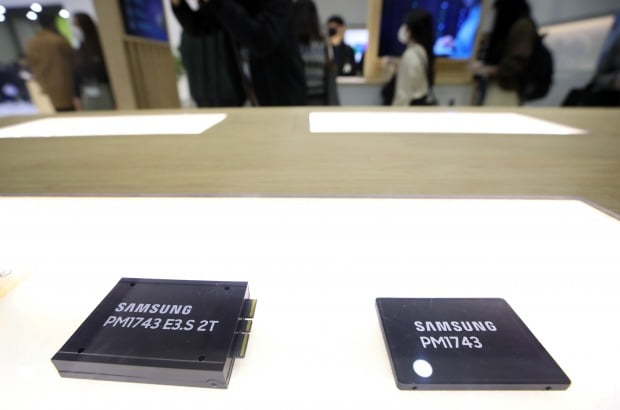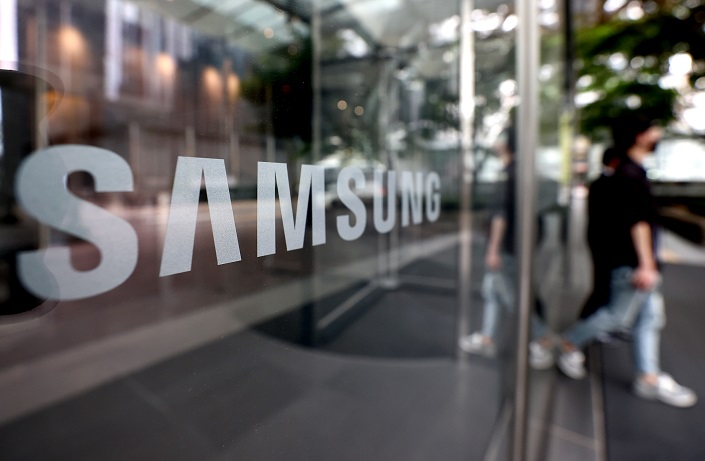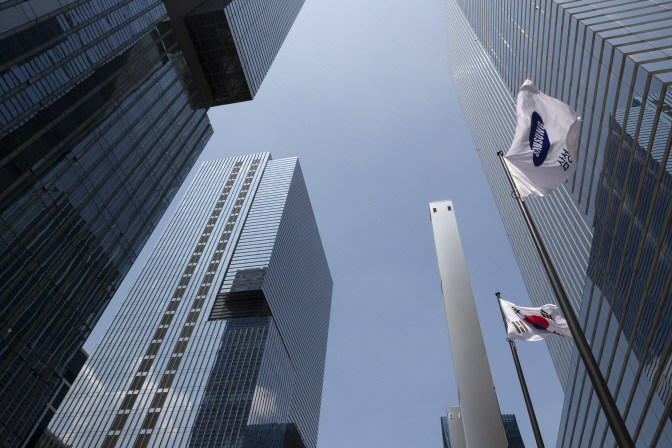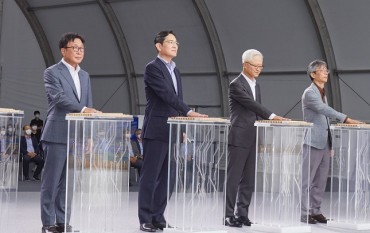
Samsung’s memory products are on display at the Korea Electronics Show (KES) 2021 at COEX in Seoul on Oct. 27, 2021. (Yonhap)
SEOUL, Oct. 28 (Korea Bizwire) — Samsung Electronics Co. on Thursday reported strong third-quarter earnings on the continued robust performance of its key semiconductor business, which took up 64 percent of the total operating profit.
Its net profit rose 31.3 percent from a year earlier to 12.29 trillion won (US$10.5 billion) in the July-September period, the world’s largest memory chip and smartphone vendor said in a regulatory filing.
Operating profit jumped 28 percent from a year ago to 15.82 trillion won, the largest since the third quarter of 2018 and the second-highest ever. Sales hit a quarterly record of 73.98 trillion won, up from 66.96 trillion won from a year earlier.
The company’s strong performance was powered largely by its chip business that has continued to show solid growth, with rising memory chip prices, enhanced yield rates and improved profitability at its chip contract manufacturing business. The weak Korean won also contributed to the company’s top and bottom lines.
The company said strong DRAM demand and an improved foundry business led to a “significant improvement in earnings” in the memory business.
Operating profit from the semiconductor unit stood at 10.06 trillion won in the third quarter, more than double the 5 trillion won a year ago.
“The overall price situation remained favorable and the company set a new record for quarterly bit shipments and the second-highest revenue for DRAM, backed in particular by significant growth in server sales,” the company said.
During the earnings call, the company provided a cautiously optimistic view about the supply chain and component shortage issues.
“We think it is not an issue of just an absolute shortage of production output of all components but rather more of a mismatch of the supply chain,” said Han Jin-man, executive vice president of Samsung’s semiconductor business.
“Things could actually start to improve earlier than expected. We are carefully hoping that perhaps the situation may start to somewhat ease in the second half of next year,” he said.
The fact that consumers have “experienced the convenience and efficiency that comes with a digital-based new normal society and lifestyle” will maintain chip demand even after the pandemic ends, he said.
Samsung’s IT & Mobile Communications division racked up revenue of 28.42 trillion won. Operating profit was 3.36 trillion won.
Market demand for mobile devices increased from the previous quarter despite “component supply constraints across the industry,” the company said, on the back of “strong sales of the company’s new flagship models: the Galaxy Z Fold3 and the Galaxy Z Flip3.”

This file photo taken June 3, 2021, shows Samsung Electronics Co.’s corporate logo at its office building in Seoul. (Yonhap)
Samsung’s display panel business continued to heavily contribute in the third quarter, with sales and operating profit reaching 8.86 trillion won and 1.49 trillion won, respectively.
The company attributed the strong sales of small and midsized OLED panels to the solid earnings results. It warned, however, the large LCD display business could continue to post losses due to a drop in prices.
Samsung will continue to produce LCD panels “until the end of this year at the request of our customers,” Choi Kwon-young, vice president at Samsung Display, said, while exercising “quite a lot of flexibility” in deciding on the future production plan for the panel.
“We are on track to mass produce and ship our QD display this fourth quarter,” in order to make a successful and “smooth transition of our large-size business toward QD displays,” he said.
Quantum Dot (QD) displays are Samsung’s next-generation displays as it speeds up its migration from the less-profitable LCD business.
Samsung’s foundry business saw its earnings improve sequentially by winning new orders. The company recently said it will make an investment decision on a new fab in the United States “as soon as possible.”
Samsung shares gained 0.86 percent to close at 70,700 won, outperforming the broader market’s 0.53 percent loss.
Meanwhile, Samsung’s consumer electronics division, comprising the visual display and digital appliance businesses, showed a disappointing performance, with sales and operating profit reaching 14.1 trillion won and 0.76 trillion won, respectively.
“Despite strong sales of its premium TVs and Bespoke home appliance products, the company recorded lower profits both quarter-on-quarter and year-on-year, due to a significant rise in material and logistics costs,” it said.
An expected fall in memory chip prices amid slower demand for IT products, as countries have moved to lift pandemic restrictions, however, could weigh on the company’s earnings in the fourth quarter.
Industry tracker TrendForce predicted DRAM prices to fall by 15 to 20 percent annually in the fourth quarter and enter a downward trend early next year, as the supply is expected to outstrip demand.
(Yonhap)







